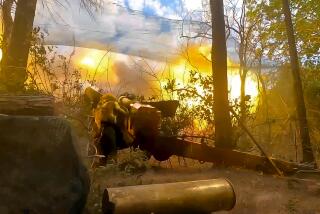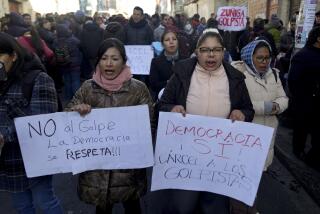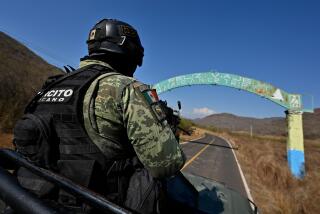Colombian Army Retakes Zone Ceded to Guerrillas
SAN VICENTE DEL CAGUAN, Colombia â Military special forces swarmed into an army base outside this sweltering frontier town Friday, three years after the government ceded it to leftist rebels along with thousands of square miles of surrounding territory.
About 900 soldiers from the Colombian armyâs Rapid Deployment Force began landing at the base in Blackhawk helicopters about 1 a.m. By dawn, they had secured the abandoned facility.
The troops met little rebel resistance. Three helicopters took hits, resulting in injuries to a pilot and two crewmen, according to armed forces chief Gen. Fernando Tapias.
There were scattered reports of clashes elsewhere, and rebels blew up transmission towers to cut all power to the vast zone that had been ceded to them for peace talks. Government officials, meanwhile, began investigating accounts saying that several villagers had been killed and maimed by a stray bomb.
The newly arrived troops trumpeted their return, the first step of a dangerous new phase in Colombiaâs nearly 40-year-old internal conflict. President Andres Pastrana called off peace negotiations Wednesday.
âToday, we have retaken the zone for the country,â said Gen. Jorge Enrique Mora, the commander of Colombiaâs army. âThere will be no more attacks or threats or terror in the zone.â
Though the takeover of the zoneâs de facto capital began smoothly, the hard work of securing the entire region, which is more than twice the size of New Jersey, remained.
The rebels--members of the Revolutionary Armed Forces of Colombia, or FARC--have run the area for almost 40 years. They spent the last three years, they say, constructing airstrips and building or fixing more than 600 miles of roads.
They also vastly expanded their presence in the zone, building tunnels and increasing their number to about 5,000, which is about a third of the rebel force.
Both sides have grown in strength during three years of fruitless talks. The FARC has expanded its presence to every province in the nation and has formed militias in the cities. And the military, thanks in part to U.S. training and equipment, has greatly increased its ability to move quickly and strike hard.
Both sides also appear ready to unleash all their might in an effort to end a deadly conflict in which the Colombian military and right-wing paramilitary groups have fought against the FARC and a smaller leftist army.
The U.S. provides Colombia with money, helicopters and troop training to fight the nationâs vast drug production system. But it has become increasingly drawn into the civil conflict as the lines have blurred between drug trafficking and the guerrillas and paramilitary groups, who all finance their activities with narcotics profits.
The rebels, in a communique issued Thursday, angrily criticized the Colombian âoligarchyâ for warmongering, saying that authorities have no interest in meeting FARC demands, such as full unemployment benefits for the millions out of work in Colombia.
âThe rupture was a demand of the military, economic guilds, the media, some presidential candidates and the U.S. Embassy, in their haste to not achieve the changes that the moment demands,â read the communique, which appeared to be signed by six rebel commanders and was distributed to media outlets here. There was no way to verify it.
Late Friday, helicopters continued to thunder over San Vicente del Caguan, which was making do with neither power nor water. The low rumble of generators could be heard everywhere. The air was filled with dense gray smoke, the product of the traditional slash-and-burn farming that takes place each February.
Residents hung white flags for peace, and hundreds gathered in the main square to demand security from national officials.
âI am very happy that they are back,â said Horace Ochoa, a 57-year-old groundskeeper who made his way along the highway with a ragged horse and a bucketful of grain. âThe FARC tried to take this place, but they werenât able to.â
Mora, the army commander, said the state planned to establish a full presence in the zone in the next few days, restoring the judges, police and district attorneys who were removed three years ago.
He also took pains to assure residents that the military would not act against them. Locals have been terrified that their long association with the guerrillas would make them targets of reprisals from both the military and its frequent partners, the right-wing paramilitary groups, which commit the majority of the countryâs massacres.
Soldiers standing outside the newly seized battalion headquarters in the morning appeared relaxed and confident. Minesweeping crews crept along the edges of the road. More troops are expected to arrive in coming days as the special forces secure the townâs airstrip.
âWe are proud to be the first ones in. We are extremely happy to be here,â said Pvt. Henry Bocanegra.
Meanwhile, the dead and wounded from a small village that apparently was accidentally bombed Thursday by Colombian air force jets arrived late Friday at the local hospital.
Family members said the bombing, which was still unconfirmed, had left three people dead and five injured in La Ye, about five hours north of San Vicente del Caguan. One young woman, identified as Yama Keni Lozada, 15, died before reaching the hospital, her legs apparently mauled by a bomb fragment.
A hospital official who did not want to be identified said metal fragments removed from the wounded appeared to be from a manufactured explosive device and not the rebelsâ homemade bombs.
Family members said they had spent most of the day in a desperate search for help. Neither the International Committee of the Red Cross nor local officials would lend their ambulances to make the trip to La Ye, in rebel-held territory, 170 miles south of the nationâs capital, Bogota.
The Red Cross and the local hospital finally sent an ambulance after villagers transported the dead and wounded to a halfway point.
One man who said he had witnessed the bombing said two Colombian Kfir jets flew over La Ye about 11:30 a.m. Thursday, dropping eight bombs near a site where men were building a road.
The man, who did not want to be identified, said the bombs killed a farmer and his 2-year-old son after striking a tree above their home. He said that the boyâs mother suffered a leg wound and that a 2-month-old baby she was holding received superficial cuts.
As a pickup truck filled with bodies arrived in town late Friday, a crowd gathered. Lozadaâs boyfriend, through choking sobs, said planes bombed them while they were working in the fields.
The angered crowd followed the truck to the cemetery. âWhy are they killing us?â some began shouting. âWe are not guerrillas.â
More to Read
Sign up for Essential California
The most important California stories and recommendations in your inbox every morning.
You may occasionally receive promotional content from the Los Angeles Times.










